Input interpretation

phenethyl alcohol
Chemical names and formulas
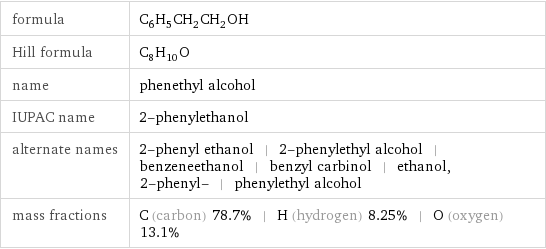
formula | C_6H_5CH_2CH_2OH Hill formula | C_8H_10O name | phenethyl alcohol IUPAC name | 2-phenylethanol alternate names | 2-phenyl ethanol | 2-phenylethyl alcohol | benzeneethanol | benzyl carbinol | ethanol, 2-phenyl- | phenylethyl alcohol mass fractions | C (carbon) 78.7% | H (hydrogen) 8.25% | O (oxygen) 13.1%
Lewis structure
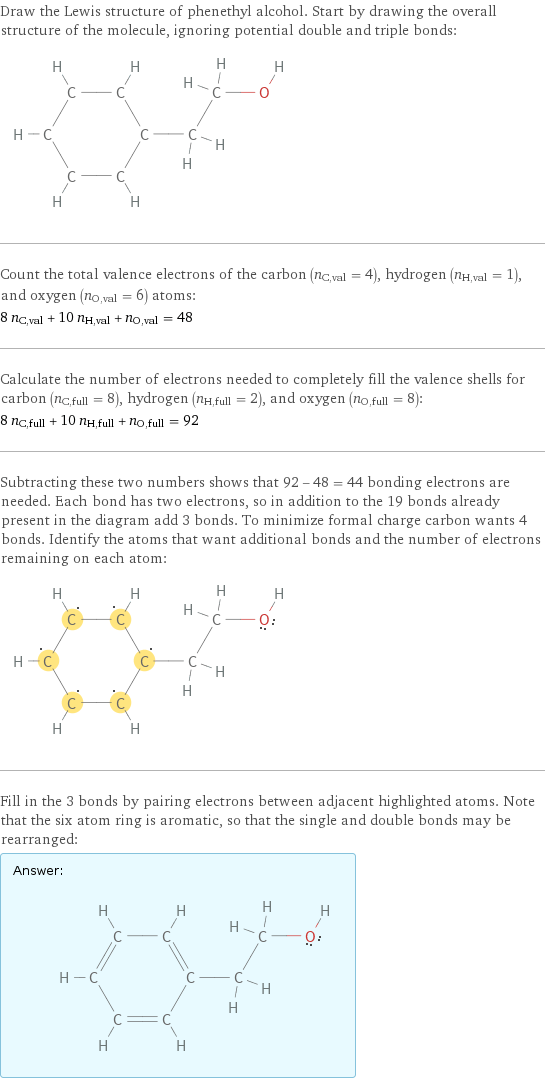
Draw the Lewis structure of phenethyl alcohol. Start by drawing the overall structure of the molecule, ignoring potential double and triple bonds: Count the total valence electrons of the carbon (n_C, val = 4), hydrogen (n_H, val = 1), and oxygen (n_O, val = 6) atoms: 8 n_C, val + 10 n_H, val + n_O, val = 48 Calculate the number of electrons needed to completely fill the valence shells for carbon (n_C, full = 8), hydrogen (n_H, full = 2), and oxygen (n_O, full = 8): 8 n_C, full + 10 n_H, full + n_O, full = 92 Subtracting these two numbers shows that 92 - 48 = 44 bonding electrons are needed. Each bond has two electrons, so in addition to the 19 bonds already present in the diagram add 3 bonds. To minimize formal charge carbon wants 4 bonds. Identify the atoms that want additional bonds and the number of electrons remaining on each atom: Fill in the 3 bonds by pairing electrons between adjacent highlighted atoms. Note that the six atom ring is aromatic, so that the single and double bonds may be rearranged: Answer: | |
3D structure

3D structure
Basic properties
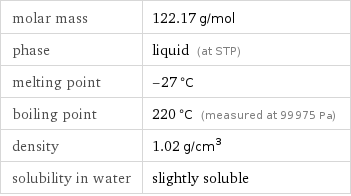
molar mass | 122.17 g/mol phase | liquid (at STP) melting point | -27 °C boiling point | 220 °C (measured at 99975 Pa) density | 1.02 g/cm^3 solubility in water | slightly soluble
Units

Hydrophobicity and permeability properties

experimental LogP hydrophobicity | 1.36 predicted LogP hydrophobicity | 1.51 predicted LogS | -1.03
Basic drug properties

approval status | experimental | small molecule drug categories | local anti-infective agent | disinfectant | pharmaceutical preservative
Liquid properties (at STP)

density | 1.02 g/cm^3 vapor pressure | 0.9998 mmHg dynamic viscosity | 0.00319 Pa s (at 50 °C) surface tension | 0.03865 N/m refractive index | 1.532
Units

Thermodynamic properties
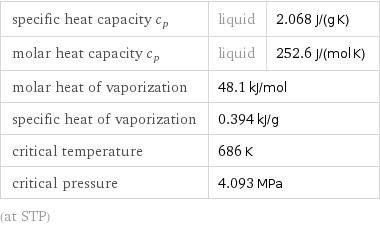
specific heat capacity c_p | liquid | 2.068 J/(g K) molar heat capacity c_p | liquid | 252.6 J/(mol K) molar heat of vaporization | 48.1 kJ/mol | specific heat of vaporization | 0.394 kJ/g | critical temperature | 686 K | critical pressure | 4.093 MPa | (at STP)
Chemical identifiers
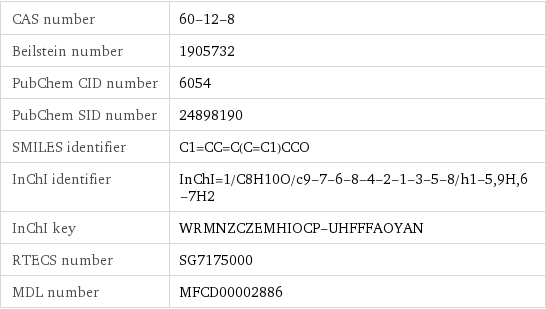
CAS number | 60-12-8 Beilstein number | 1905732 PubChem CID number | 6054 PubChem SID number | 24898190 SMILES identifier | C1=CC=C(C=C1)CCO InChI identifier | InChI=1/C8H10O/c9-7-6-8-4-2-1-3-5-8/h1-5, 9H, 6-7H2 InChI key | WRMNZCZEMHIOCP-UHFFFAOYAN RTECS number | SG7175000 MDL number | MFCD00002886
NFPA label

NFPA label

NFPA health rating | 1 NFPA fire rating | 1 NFPA reactivity rating | 0
Safety properties
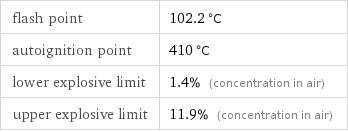
flash point | 102.2 °C autoignition point | 410 °C lower explosive limit | 1.4% (concentration in air) upper explosive limit | 11.9% (concentration in air)

DOT hazard class | 6.1 DOT numbers | 2810
Toxicity properties

RTECS classes | mutagen | reproductive effector | primary irritant